|
< Earlier Kibitzing · PAGE 3 OF 3 ·
Later Kibitzing> |
| Oct-12-12 | | David2009: A Bezgodov vs M Zhunusov, 1994 White 18? The immediate 18.Bxg7 Nxg7 19.f6 is met by Ng6 so remove the N first: 18.Rxe5 dxe5 19.Bxg7 GOOT! Main variation: 19...Nxg7
20.f6 Bxf6 21.Nxf6+ Kh8 22.Rxd7 and White is ahead on material with a strong attack. The f7 Pawn falls. Time to
check:
====
White finds an alternative and better win at move 19:
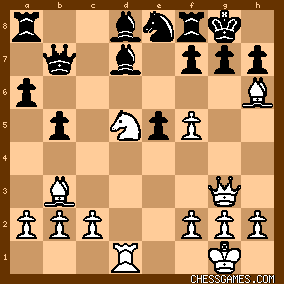
click for larger view
19.f6! instead of 19.Bxg7. On playing through the game I note a major flaw in my analysis: White is a piece down in the puzzle position, so I am not material up at the end of my line. Here's as far as I had analysed in the 19.Bxg7 line:
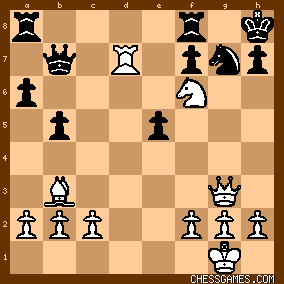
click for larger view
(Black to play 22...?). I am cheered to discover from <LTJ>'s excellent analysis that White is indeed winning, and that this position is another GOOT! (if 22...Q moves 23.Qh4 GOOT 3! because of the mate threat on h7). If you can't be good - be lucky! Crafty EGT is still off-line and I am having severe withdrawal symptoms (I can't compare the two winning methods), but here's a Crafty End Game Trainer link to the position at move 19 for when (if ever) the EGT comes back: http://www.chessvideos.tv/endgame-t.... |
|
| Oct-12-12 | | agb2002: White has a pawn for a knight.
Black threatens 18... Bxf5 and ... Bg6.
The first idea is 18.Bxg7 Nxg7 19.f6 but the knight on e5 can go to g6, blocking the g-file. This suggests 18.Rxe5 dxe5 (White's menace was 19.Rxe8 Rxe8 20.Qxg7#) 19.Bxg7: A) 19... Nxg7 20.f6 Bxf6 21.Nxf6+ Kh8 22.Rxd7
A.1) 22... Rad8 23.Qd3
A.1.a) 23... e4 24.Rxd8 Qe7 25.Qxe4 Nf5 26.Qxe7 Nxe7 27.Rxf8+ Kg7 28.Nd7 + - [R+2P]. A.1.b) 23... Nf5 24.Qxf5 Kg7 25.Qg5+ Kh8 26.Nh5 Rg8 27.Rxd8 + - [B+N+P]. A.2) 22... Qc6 23.Qh4 h5 24.Qg5 Nf5 25.Qxf5 + - [B+N+P vs R]. A.3) 22... Qxd7 23.Nxd7 Rad8 24.Qh3 Rfe8 25.g3 + - [Q+B+2P vs 2R]. A.4) 22... Nh5 23.Nxh5 with the double threat 24.Qg7# and 24.Rxb7 (23... Rg8 24.Qxe5+). A.5) 22... Nf5 23.Qxe5 with the double threat 24.Rxb7 and 24.Qxf5. B) 19... Bh4 20.Ne7+ Bxe7 21.Bf6+ and mate next.
C) 19... Bxf5 20.Bxf8+
C.1) 20... Kxf8 21.Qxe5 f6 (21... Bg6 22.Qh8#) 22.Qxf5 + - [2P]. C.2) 20... Bg6 21.Qxe5 is similar to C.1. |
|
| Oct-12-12 | | LoveThatJoker: <David2009> Thanks for the kind words, man! I appreciate them most sincerely. I agree with you that my analysis is strong; this said, I must make note of another point of importance - aside from that which I noted in my follow-up post (i.e., 19...Bf5! =) In my sub-sub variation, 18. Rxe5! dxe5 19. Bxg7? Nxg7? 20. f6 Bxf6 21. Nxf6+ Kh8 22. Rxd7! Qc6 23. Qh4 Nh5 24. Nxh5 h6! we get this position: 
click for larger viewHere as I was formulating my solution post - as always without moving pieces by hand and based solely on the initial position on the diagram - I missed the fact that White doesn't have 25. Qd4+ because the pawn on e5 now blocks the long diagonal and covers the d4 square. Therefore, without the help of Stockfish, I'm seeing that White can win via the following ways here: A) 25. Qg3 Qg6 26. Qxe5+ f6 27. Nf4!! 
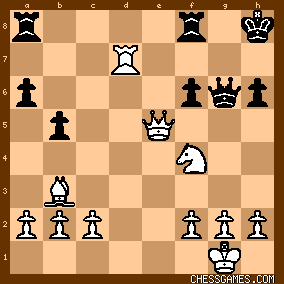
click for larger viewB) 25. Qg3 Rg8 26. Qxe5+ f6
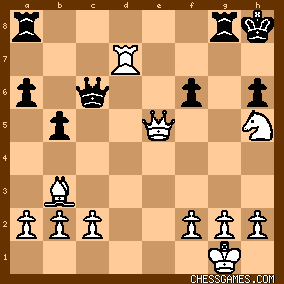
click for larger viewB.1) 27. Qxf6+ Qxf6 28. Nxf6 Rg7 29. Rxg7 Kxg7 30. Nd5  
click for larger viewB.2) 27. Rh7! Kxh7 28. Nxf6+ Kg6 29. Nxg8 

click for larger viewC) 25. Nf6 Kg7 26. Rd3 
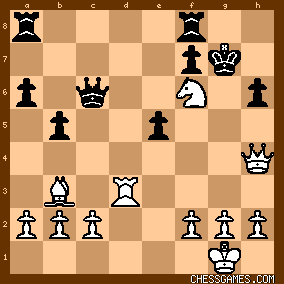
click for larger viewLTJ |
|
| Oct-12-12 | | Abdel Irada: <LTJ> and <David2009>: Have you looked at the defense 18. Rxe5!, dxe5; 19. Bxg7?!, Nxg7?!; 20. f6, Bxf6; 21. Nxf6+ Kh8; 22. Rxd7, Qxd7!; 23. Nxd7, Rfd8; 24. Qg4, f5!!, which appears to equalize? I think that, even if 19. ...Bf5 were to be refuted, this calls the entire line with the bishop sac on g7 into question. I presume this is why Bezgodov preferred 19. f6. |
|
| Oct-12-12 | | LoveThatJoker: <Abdel Irada> Thanks for mentioning the 22...Qxd7 possibility. Without Stockfish's help, but with moving the pieces by hand, I came up with this: 22...Qxd7 23. Nxd7 Rfd8 24. Qf3 e4 (24...Ra7 25. Nxe5  ) 25. Qxf7! Ra7 26. Be6! ) 25. Qxf7! Ra7 26. Be6!  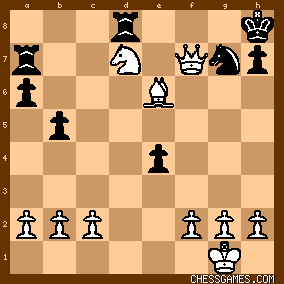
click for larger viewLTJ |
|
Oct-12-12
 | | paulalbert: I went for f6 first. Missed the need to get rid of N first by Rxe5. |
|
| Oct-12-12 | | Abdel Irada: <LTJ>: Very creative! I'd overlooked that Black can't get away with taking the bishop thanks to the zwischenzug 27. Qf6†. Congratulations on breaking down that line of defense. |
|
| Oct-12-12 | | LoveThatJoker: <Abdel Irada> Thanks, man! LTJ |
|
Oct-12-12
 | | LIFE Master AJ: After about five minutes of analysis, I decided on 18.RxN/e5. (Can't find a clear win without an engine, though.) |
|
| Oct-12-12 | | rilkefan: <Abdel Irada>, fwiw stockfish plays ...Rad8 instead of ...Rfd8 to avoid Qf3, but gets untangled after 23... Rad8 24. Qd3 e4 25. Qd6 a5 26. c3 a4 27. Bd5 f5 28.Bc6. It considers 19. Bxg7 Bxf5 20. Bxe5+ Bg6 21. h4 as +0.7 at a depth of 26 (0.3 Gnodes). Here's a sample line: Ng7 22. Bxg7 Kxg7 23. h5 Rc8 24. hxg6 hxg6 25. Qe5+ f6 26. Qe6 Rc6 27. Nf4 Rxe6 28. Nxe6+ Kh8 29. Nxf8 Be7 30. Nxg6+. Here white supposedly holds a large advantage as noted but I wouldn't want to prove it. Needless to say I didn't consider this when choosing the much better 18.Bxg7 instead. |
|
Oct-12-12
 | | LIFE Master AJ: Alexei Bezgodov - Marat Zhunusov [B87]
Kstovo, 1994.
[A.J.G.]
1.e4 c5; 2.Nf3 d6; 3.d4 cxd4; 4.Nxd4 Nf6;
5.Nc3 a6; 6.Bc4 e6; 7.Bb3 b5; 8.0-0 Be7;
9.Qf3 Qb6; 10.Be3 Qb7; 11.Qg3 0-0; 12.Bh6 Ne8;
13.Rfe1 Bd7; 14.Rad1 Nc6; 15.Nd5 Bd8;
16.Nf5 exf5; 17.exf5 Ne5;

click for larger viewWe have arrived at out position for today's POTD.
18.Rxe5! dxe5; 19.f6! g6!?;
I thought that this was bad, but <apparently!!! <<<>>>> it was not that much worse than some of the alternatives. [19...Qc6; <box> ("▢")
Apparently forced.
20.Bxg7! Bf5; 21.Bh6+ Bg6; 22.Ne7+ Bxe7; 23.fxe7 Nf6; 24.exf8Q+ Rxf8; 25.Bxf8 Kxf8; 26.Qxe5, "  "
I miscounted here ... there was the <old problem> of a phantom Rook on a8 ... White is, (of course!) winning easily. "
I miscounted here ... there was the <old problem> of a phantom Rook on a8 ... White is, (of course!) winning easily. Black also loses after:
RR 19...Bxf6; 20.Nxf6+ Kh8;
I saw this much.
21.Nxe8!,
But I completely missed the fact that this was a DOUBLE attack on g7. (I looked only at: </= 21.Rxd7, and did not see it as a clear win, although the engine says its an easy "1-0" for White. ) 21...Bg4; 22.Bxg7+ Kg8; 23.Qxg4,  ] ]
20.Ne7+ Bxe7; 21.fxe7
1-0 |
|
Oct-12-12
 | | LIFE Master AJ: Analysis by Fritz 13, checked with Houdini. |
|
| Oct-12-12 | | psmith: Does it count for something that I didn't see the game line, but did see the ...Bf5 defense to the Rxe5 and Bxg7 line? |
|
| Oct-12-12 | | kevin86: Black rook is trapped by a pawn! |
|
| Oct-12-12 | | Abulherar: i think that white's best move is:18.f6!
A)18...♘xf6 19.♕xg7#
♗)18...♗xf6 19.♘xf6+ ♘xf6 20.♕xg7#
C)18...g6 19.♘e7+ ♗xe7 20.fxe7 |
|
| Oct-12-12 | | Abulherar: 19.f6 was white's best move after:18.Rxe5!
because the black N on e5 can stop white's attack if:18.f6 Ng6! |
|
| Oct-12-12 | | James D Flynn: White is down a piece for a pawn but his pieces are poised to threaten the Black K defense, in particular the g7 pawn. The g7 pawn is currently protected by the N on e8, if White could exchange that N by say Nf6+ he would mate but that move is answered by Bxf6. The position of the N has the disadvantage that the R on f8 has no squares and if attacked by a pawn it is lost so 18.f6 looks promising threatening both fxg7 and Ne7+. The pawn cannot be taken because 18…..Bxf6 leads to 19.Nxf6+ and mate on g7 but Black can shield the g7 pawn from the White Q by 18…..Ng6. Let’s examine possible continuation from that defense and, if unsatisfactory for White, try 18.Rxe5 instead of the immediate 18.f6.
18.f6 Ng6(if g6 19.Ne7+ Bxe7 20.fxe7 and exf8=Q= next) 19. Ne7+ Bxe7 20.Qxg6(if fxe7 Nxe7 21.Rxe7(White has restored material equality and threatens Rxe8 and mat e on g7) Kh8 22.Bxf7(if Rxe8 gxh6 23.Bxf7 Raxe8 24.Qc3+ Re5 25.f4 Rxf7 26.fxe5 Rg7 27.g3 dxe5 28.Qxd5 Bc6 and White is down a piece and his own K is in danger) Rxf7(if gxh6 23.Qc3#) 23.Rxf7 Kg8 24.Rxg&+ Kf8 25.Rxd7+ Ng7 26.Qxg7#.This line appears to be winning but it is long and complicated, over the board I would certainly look at 18.Rxe5 which looks quicker and simpler.
18.Rxe5 dxe5(otherwise Rxe8) 19.f6 g6(ifBxf6(Black cannot allow fxg7) 20.Nxf6+ Kh8 21.Nxe8 g6 22.Qxe5+ f6 23.Bg7#) 20.Bxf8(Whte is now a pawn and the exchange up and threatens Bxf7)Be6 21.Bxe6 fxe6 22. Qxe5 Bxe7 23.fxe7+ Kg8 24.Qxe6+ Kh8 25.Qf7(threat 26.Bg7+ Nxg7 27.Qf8+ Rxf8 28.exf8=Q#) h5 26.Bh8 Qe4 27.Be3 Ng7 28.Bd4 Rg8 29.Bxg7 Kh7(if Rxg7 30.e8=Q+) 30.Bc3+ Kh6 31.Qxg8 and wins. |
|
| Oct-12-12 | | Patriot: I'm wondering if there are several ways to win this. My candidates are 18.f6 and 18.Bxg7. 18.f6
18...Bxf6 19.Nxf6+ 
18...Ng4 19.fxg7 Nxg7 20.Bxg7 Kxg7 21.f3 
18...g6 19.Ne7+ Kh8 20.Bxf8 
18.Bxg7 Nxg7 19.f6 Bxf6 20.Nxf6+ doesn't look as promising as 18.f6. So I'm going with 18.f6. |
|
| Oct-12-12 | | Patriot: So I missed the simple 18...Ng6, which is why 18.Rxe5 is key. |
|
| Oct-12-12 | | bischopper: how to watch this sacrificy? how to be on a place that look easy? |
|
| Oct-12-12 | | dgbuckmeister: <Phony Benoni> see second Kibitz on P.1 <went for 18.Rxe5 dxe5 19.Bxg7 Nxg7 20.f6 Bxf6 21.Nxf6+ Kh8 22.Rxd7 .....> mating quite simply with Blk K on h8, Wh N on f6 and Wh Q on h6 or h7. I did too, and I think it works. Did anyone else consider or analyse this alternative line? |
|
| Oct-12-12 | | Patriot: In my opinion, 18.f6 is the most logical candidate but after seeing 18...Ng6 (like I should have done) 18.Rxe5 would be added as a candidate. It's a case of one candidate leading to another. |
|
| Oct-12-12 | | stst: 18.f6 is the main line,
IF (A)....Bxf6; 19.Nxf6+ Nxf6; 20.Qxg7#
IF (B)....Nxf6; 19.Qxg7#
IF (C)....g6; 19.Ne7+
if (i)....Bxe7; 20.fxe7 Nf6; 21.Bd5 Qb8; 22.Bxa8 Qxa8; 23.exf8+ Qxf8; 24.Bxf8 Kxf8 and Black is heavily down in material.
if (ii)... Kh8; 20.Bxf8 etc with an easy win for W.
Check the main line... |
|
| Oct-12-12 | | stst: Yeah, got that, but the actual game differs somewhat from the diagram given on front page. Process stays the same though. |
|
| Oct-13-12 | | morfishine: Black is up a piece for a pawn, but White is way ahead in development and all of his pieces are active; Black KIng rook is boxed in defending <f7> while Black Queen rook is passive. Contrast that with the White rooks Black's only threat is <Bxf5> hurrying his WSB to defend the Kingside Three candidates come to mind: <18.f6> and <18.Bxg7> and <18.Rxe5> Having sorted through this from 4-430am, I left for work with no answer. I decided to let my subconcious "work" on the problem while I actually worked. At around 2pm, my subconcious, or 'inner-self' "notified" me that it had a solution: EUREKA!! was the message: <18.f6 g6 19.Ne7+ Kh8 20.Bxf8> capturing the undefended rook. But alas, after returning home, 'concious me' notified my subconcious that 18...Ng6 and Black holds on I then began to focus on the one resource at Black's disposal, namely <Bxf5> or <Bf5>. From there, I began to spy the only Black piece actively placed: the knight on <e5>. This led me to <18.Rxe5>, which accomplishes much: (1) Black's only active piece is eliminated (2) the pawn on <f5> is defended & (3) 19.Rxe8 is threatened. Black must accept the sacrifice, going up a whole rook. So, <18...dxe5> Now <19.f6> is very strong, (since Black no longer has <Ng6> at his disposal) and the point of White's attack is <19...g6 20.Ne7+> and Black can't play <20...Bxe7> due to <21.fxe7> and Black's rook is undefended Frankly, I stopped here, thinking "The Orioles are coming on soon to battle the Yanks for a shot at the American League Championship Series, and besides, I'm really tired of trying to visualize this whole thing without resorting to a board, [which I almost did]" I was astonished, literally, to see that this is precisely what was played and where Black resigned! I can't claim success in this line as I failed to visualize the final, crushing poinrt behind the whole combination and for all intents and purposes, wrote it off as something that Black has to avoid: except that he can't!! **I was thinking that Black could somehow defend with either 21...Ng7 or 21...Nf6 and though it was exciting, it was probably just another dead-end. |
|
 |
 |
|
< Earlier Kibitzing · PAGE 3 OF 3 ·
Later Kibitzing> |





